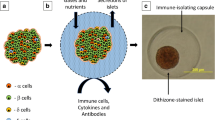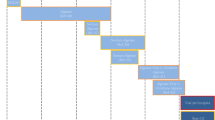Abstract
Islet transplantation is one of the promising ways to treat diabetes. To reduce the immune system response, several methods have been developed, a novel one being the grafting of methoxy polyethylene glycol (mPEG) derivatives onto collagen capsules of islets. In this study, the effects of the first and second generations of activated mPEG on the immunological response of polyethylene glycol (PEG) grafted pancreatic islets were studied. mPEG-Succinimidyl carbonate (mPEG-SC) and mPEG-succinimidyl propionic acid (mPEG-SPA) (with nominal molecular weight 5 kDa), typical of the first and second generations of activated mPEG, were selected, respectively. Both activated mPEGs did not affect the morphology, viability, or functionality of PEGylated islets compared to free islets (naked islets). The amount of IL-2 secreted from lymphocytes co-cultured with mPEG-SPA grafted islets (131.83 ± 15.28 pg/ml) was not significantly different from that with mPEG-SC grafted islets (156.09 ± 27.94 pg/ml). These results indicated that both mPEG-SC and mPEG-SPA had the same effect for camouflaging Langerhans islets, but the former is more suitable due to its easier synthesis process.






Similar content being viewed by others
References
Alberti KG, Aschner P, Groop L. Part1: diagnosis and classification of diabetes mellitus: WHO consultation. Geneve: World Health Organization, Department of Noncommunicable Disease Surveillance; 1999.
Graham RM. Cyclosporine: mechanisms of action and toxicity. Clevel Clin J Med. 1994;61:308–13.
Neithammer D, Deschner JK, Dannecker GE. Side effect of long term immunosuppression versus morbidity in autologous stem cell rescue: striking the balance. Rheumatology. 1999;38:747–50.
Shapiro AMJ, Ryan EA, Lakey JRT. Pancreatic islet transplantation in the treatment of diabetes mellitus. Best Pract Res Clin Endocrinol Metab. 2001;15:241–62.
Beck J, Angus R, Madsen B, Britt D, Vernon B, Nguyen KT. Islet encapsulation: strategies to enhance islet cell functions. Tissue Eng. 2007;13:589–99.
Prokop A. Bioartificial pancreas: materials, devices, function, and limitations. Diabetes Technol Ther. 2001;3:431–49.
Lim F, Sun AM. Microencapsulated islets as bioartificial endocrine pancreas. Science. 1980;210:908–10.
Silva AI, de Matos A, Brons IG, Mateus M. An overview on the development of a bio-artificial pancreas as a treatment of insulin-dependent diabetes mellitus. Med Res Rev. 2006;26:181–222.
Veronese FM, Mero A, Pasut Gianfranco. Protein PEGylation, basic science and biological applications. In: Veronese FM, editor. PEGylated protein drugs: basic science and clinical applications. Basel: Birkhäuser Verlag Publication; 2009. p. 11–31.
Hashemi Najafabadi S, Vasheghani Farahani E, Shojaosadati SA, Armstrong JK, Moin M, Pourpak Z. A method to optimize PEG-coating of red blood cells. Bioconjugate Chem. 2006;17:1288–93.
Li RH. Materials for immunoisolated cell transplantation. Adv Drug Del Rev. 1998;33:87–109.
Koswolski A, Harris JM. Protein pegylation. New life for an old technology. In: Yui N, Jeong SY, editors. Biomaterials and drug delivery toward new mellenium. Seoul: Han Rim Won Publishing Co.; 2000. p. 63–74.
Lee DY, Yang K, Lee S, Chae SY, Kim KW, Lee MK, Han DJ, Byun Y. Optimization of monomethoxypolyethylene glycol grafting on the pancreatic islet capsules. J Biomed Mater Res. 2002;62:372–7.
Terumara Y, Iwata H. Surface modification of islets with PEG-lipid for improvment of graft survival in intraportal transplantation. Transplantation. 2009;88:624–30.
Heman S, Hooftman G, Schacht E. Poly(ethylene glycol) with reactive endgroups: I. Modification of proteins. J Bioact Compat Polym. 1995;10:145–87.
Roberts MJ, Harris JM. Attachment of degradable poly(ethyleneglycol) to proteins has the potential to increase therapeutic efficacy. J Pharm Sci. 1998;87:1440–5.
Harris JM, Kozlowski A. Poly(ethylene glycol) and related polymers monosubstituted with propionic or butanoic acids and functional derivatives thereof for biotechnical applications. 1997. US patent 5672662.
Jang JY, Lee DY, Park SJ, Byun Y. Immune reactions of lymphocytes and macrophages against PEG-grafted pancreatic islets. Biomaterials. 2004;25:3663–9.
Le Y, Scott MD. Immnunocamouflage: the biophysical basis of immunoprotection by grafted methoxypoly(ethylene glycol) (mPEG).Acta Biomater. 2010. doi:10.1016/j.actbio.2010.01.031.
Miron T, Wilcheck MA. A simplified method for preparation of succinimidyl carbonate polyethylene glycol for coupling to proteins. Bioconjugate Chem. 1993;4:568–9.
Rosen P, Kwang N. Novel monofunctional polyethylene glycol aldehydes. 2003. US patent no. 20030153694A1.
Lacy PE, Kostinovsky M. Method for the isolation of intact islets of Langerhans from the rat pancreas. Diabetes. 1967;16:35–9.
Bank HL. Assessment of islet cell viability using fluorescent dyes. Diabetologia. 1987;30:812–6.
Lee DY, Park SJ, Nam HJ, Byun Y. A combination therapy of PEGylation and immunosuppressive agent for successful islet transplantation. J Control Release. 2006;110:290–5.
Lee DY, Park SJ, Nam HJ, Byun Y. A new strategy toward improving immunoprotection in cell therapy for diabetes mellitus: long-functioning PEGylated islets in vivo. Tissue Eng. 2006;12:615–23.
Acknowledgments
This work was supported by grant no. S88P/3/1518 from the Ministry of Health and Medical Education, the Deputy of the Research and Food and Drugs Department, Islamic Republic of Iran.
Author information
Authors and Affiliations
Corresponding author
Rights and permissions
About this article
Cite this article
Aghajani-Lazarjani, H., Vasheghani-Farahani, E., Shojaosadati, S.A. et al. The effect of two different polyethylene glycol (PEG) derivatives on the immunological response of PEG grafted pancreatic islets. J Artif Organs 13, 218–224 (2010). https://doi.org/10.1007/s10047-010-0525-9
Received:
Accepted:
Published:
Issue Date:
DOI: https://doi.org/10.1007/s10047-010-0525-9




